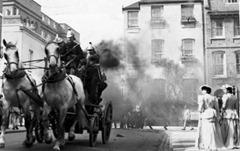 Apart from the first three years after I left school, my entire working and very enjoyable career was spent in the fire service. It is only natural with such length of service that one will glean a lot of fire service knowledge, both modern and historical. Much historical knowledge came from the older hands at the job when I first joined. Quite a number of them had joined after the end of WW2 when they were still relatively young and who in turn had knowledge passed onto them by the wizened firefighters of their day. Fire stations still exist today that were originally built in the 19th century at a time when fire appliances, (fire engines), as we know them today did not exist, but consisted of horse drawn steamer pumps with firefighters clinging to the sides.
Apart from the first three years after I left school, my entire working and very enjoyable career was spent in the fire service. It is only natural with such length of service that one will glean a lot of fire service knowledge, both modern and historical. Much historical knowledge came from the older hands at the job when I first joined. Quite a number of them had joined after the end of WW2 when they were still relatively young and who in turn had knowledge passed onto them by the wizened firefighters of their day. Fire stations still exist today that were originally built in the 19th century at a time when fire appliances, (fire engines), as we know them today did not exist, but consisted of horse drawn steamer pumps with firefighters clinging to the sides.
In the fire service when any piece of equipment becomes defective, be it as large as a fire appliance or as small as a hand-held radio, it is described as being “Off the Run”. Conversely any equipment that is fit for use is deemed to be “On the Run”. Often defective equipment has a label tied onto it with the abbreviation OTR.
Other industries also use these terms too.
The origins of this short phrase however are from the fire service of yesteryear when appliances were those horse drawn steamers. Like today, even in the 1800’s, everything the fire service is designed for a speedy turnout from the station as the longer the delay, the greater the chance of loss of life. Horses were always kept in the stables located immediately to the rear of the large appliance rooms where the steamer pumps were located in immediate readiness to go to a fire with a constantly lit boiler. The stables doors were normally spring loaded and could be opened either automatically or by pulling on a rope. As soon as the station call-out alarm sounded, the stable doors would open and well trained horses that knew what to do, simply trotted unaided from their stable into the appliance room, to stand alongside the shafts of the steamer pump. Suspended above their heads and fixed in a opened-out position in a cradle was the harness which could be easily and quickly lowered onto the horses. The rear end of the harness was already attached to the steamer and a rope and pulley system allowed the harnesses to be quickly lowered onto the horses which could then be rapidly fitted by the means of quick attachment buckles. Counterweights and springs would then lift the cradle high into the air and out of the way of proceedings.
To further assist the steamer and its crew to rapidly get out of the station, the floor where the steamer was parked was sloped to help overcoming the initial inertia in getting the steamer moving. As soon as the brake was released the steamer would start to roll forward and this assisted the horses to leave the station at the gallop. The sloped floor was known as “The Run” and if the steamer was fired up and ready to use it was said to be “On the Run”. It was said that from the time of receiving a fire call, the horses could be out of the stables, harnessed and out of the station in two minutes or less. Some claimed this could even be as quick as 30 seconds.
The attached film clip shows the turn-out of a horse-drawn steamer from a US fire house but the methods depicted are virtually identical to the old UK fire stations.
The pumps on these steamers were piston powered and operated in a similar way to the pistons on a steam train. The disadvantages was this also caused the water to squirt out of the jets in a pulsating movement and the pistons could not pump against the branches (jets) if they were closed. A large sealed metal dome was fitted to these pumps to absorb extra water from the pistons and help smooth out pulsations in the jet. Todays pumps are what is known as centrifugal pumps that have no pistons but are fitted with a internal spinning disc known as an impeller. This allows water to flow at a even pressure at all times even if the branch is open or closed.
Filed under: Firefighting Stories, One the Run | Tagged: appliance room, fast turn out, fire brigade, fire horses, fire service history, horse drawn steamer, horse harness, On the Run, OTR, sloped floor, steamer pump | Leave a comment »






